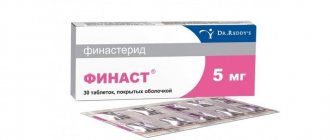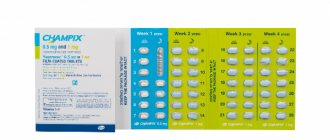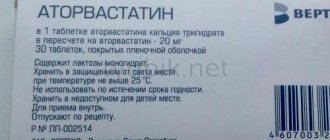Release form and composition
Finast is produced in the form of film-coated tablets: round, biconvex, white or almost white, smooth on one side and embossed FIN on the other (10 pieces in strips, 3 strips in a cardboard package).
Composition per 1 tablet:
- active ingredient: finasteride – 5 mg;
- auxiliary components: microcrystalline cellulose, pregelatinized corn starch, magnesium stearate, lactose, sodium carboxymethyl starch, sodium docusate;
- film shell: titanium dioxide, hypromellose, talc, propylene glycol.
Pharmacological properties
Pharmacodynamics
Finast is an antitumor hormonal drug. Its active ingredient, finasteride, is a synthetic 4-azasteroid compound that specifically and competitively inhibits steroidal 5-alpha reductase. 5-alpha reductase is an intracellular enzyme that converts testosterone to 5-alpha-dihydrotestosterone (a more active androgen).
When testosterone is converted to dihydrotestosterone, prostate tissue grows and benign hyperplasia develops. The drug helps to inhibit the stimulating effect of testosterone on tumor growth. Under the influence of finasteride, within 24 hours after taking the drug orally, the concentration of 5-alpha-dihydrotestosterone in the prostate tissue and in the blood plasma significantly decreases. This leads to a decrease in the volume of the prostate gland, an increase in the maximum flow rate of urine and a decrease in signs of urinary tract obstruction.
With continuous use of Finast, a statistically significant effect is observed after 3 months (decrease in prostate volume), 4 months (increase in maximum urine flow rate) and 7 months (reduction in signs and symptoms of urinary tract obstruction).
Finast does not affect plasma lipid levels or the plasma concentrations of prolactin, estradiol, cortisol, thyroxine and thyroid-stimulating hormone.
Pharmacokinetics
After oral administration of the drug, finasteride is quickly absorbed from the digestive tract and penetrates into biological fluids and tissues, including found in seminal fluid. The absolute bioavailability of finasteride is approximately 80%. Food intake does not affect the bioavailability of the drug.
The maximum plasma concentration of the active substance is achieved 1–2 hours after taking Finast orally. Finasteride is 90% bound to plasma proteins.
Metabolism of the drug occurs in the liver. About 57% of finasteride is excreted in feces and 39% in urine. The half-life is 6–8 hours (6 hours in patients aged 18–60 years and up to 8 hours in patients over 70 years of age).
When taking the drug at a dose of 5 mg per day for 3–7 months, the serum concentration of 5-alpha-dihydrotestosterone decreases by 70%.
Finast, 5 mg, film-coated tablets, 30 pcs.
Side effects identified during clinical trials
The PLESS study assessed the safety of finasteride over 4 years in 1,524 patients treated with finasteride versus 1,516 patients treated with placebo.
Seventy-four patients (4.9%) in the finasteride group discontinued therapy due to drug-related side effects, compared with 50 patients (3.3%) in the placebo group. Fifty-seven patients (3.7%) in the finasteride group and 32 patients (2.1%) in the placebo group discontinued treatment due to side effects related to sexual dysfunction, which were the most commonly reported side effects.
The only clinical adverse reactions that were considered by the investigators to be possibly, probably, or definitely drug-related, and whose incidence with finasteride was greater than 1% and greater than that with placebo during the 4-year study period, were those related to sexual dysfunction. functions, breast tenderness and skin rash. In the first year of treatment, sexual dysfunction was detected in 8.1% of patients in the group taking finasteride and 3.7% in the placebo group; decreased libido – in 6.4% and 3.4%; and ejaculation disorders – 0.8% and 0.1%, respectively. When using the drug in years 2-4 of the study, the incidence of the above side effects in patients taking finasteride did not differ significantly from that in patients taking placebo.
The total incidence of side effects during 2-4 years of the study was: impaired sexual function (5.1% in the drug group and 5.1% in the placebo group), decreased libido (2.6% in both groups), impaired ejaculation (0 .2% and 0.1% respectively). Within 1 year, a decrease in ejaculate volume was detected in 3.7% and 0.8% in the drug group and placebo group, respectively; and during 2-4 years of the study - 1.5% and 0.5%, respectively. Breast enlargement (0.5% and 0.1%, respectively), breast tenderness (0.4% and 0.1%, respectively), and skin rash (0.5% and 0) were also reported at 1 year. .2% respectively). Over the course of 2–4 years, the total incidence of these phenomena was: enlargement of the mammary glands (1.8% and 1.1%, respectively), pain in the mammary glands (0.7% and 0.3%, respectively), skin rash (0 .5% and 0.1% respectively).
In a 7-year placebo-controlled study that included 18,882 healthy men, needle biopsies (9,060 men) revealed prostate cancer in 18.4% of patients treated with finasteride and in 24.4% of patients treated with finasteride. those receiving placebo. 280 men (6.4%) in the finasteride group and 237 men (5.1%) in the placebo group had prostate cancer, which was assessed by needle biopsy as Gleason score 7–10. Additional analysis suggested that the increased incidence of high-grade cancer observed in the finasteride group may be due to diagnostic bias associated with the drug's effect on prostate volume. In approximately 98% of all cancers diagnosed, the tumor was classified as intracapsular (stage T1 or T2) at diagnosis. The clinical significance of the findings regarding Gleason score 7–10 prostate cancer in this study is unknown.
In the MTOPS study, the safety and tolerability profile of combination treatment with finasteride 5 mg per day and doxazosin 4 mg or 8 mg per day was comparable to the safety and tolerability of each agent alone. During the 4- to 6-year, placebo-controlled, active-drug control MTOPS study in 3047 men, there were 4 cases of breast cancer in men taking finasteride and no cases in men not taking finasteride. During the 4-year, placebo-controlled PLESS study of 3,040 men, there were 2 cases of breast cancer in men receiving placebo and no cases in men taking finasteride. In the 7-year, placebo-controlled Prostate Cancer Prevention Trial (PCPT) of 18,882 men, there was 1 case of breast cancer in a man taking finasteride and 1 case of breast cancer in a man taking finasteride. receiving placebo. There have been post-marketing reports of cases of breast cancer in men taking finasteride. The relationship between long-term use of finasteride and the occurrence of breast neoplasia in men has not yet been established.
Post-marketing experience of use
The following additional adverse effects of finasteride at low doses have been reported in post-marketing experience. Because these reactions were reported on a voluntary basis in a population of unknown size, it is not always possible to reliably estimate their frequency or establish a causal relationship to drug exposure.
From the immune system: hypersensitivity reactions such as itching, urticaria and angioedema (including swelling of the lips, tongue, larynx and face). From the mental side: depression, decreased libido, which may continue after cessation of treatment.
From the reproductive system and mammary glands: sexual dysfunction (erectile dysfunction and ejaculation disorders), which may continue after cessation of treatment; testicular soreness; male infertility and/or decreased quality of seminal fluid. Semen quality was reported to normalize or improve after discontinuation of finasteride.
Laboratory indicators
When assessing laboratory parameters of prostate-specific antigen (PSA), the decrease in its concentration in patients taking finasteride should be taken into account.
There were no other differences in the levels of standard laboratory parameters between the groups of patients receiving finasteride placebo.
Side effects
- reproductive system: impaired ejaculation, decreased ejaculate volume, decreased libido and/or potency;
- endocrine system: tenderness of the mammary glands, enlargement of the mammary glands, decreased concentrations of PSA (prostate-specific antigen), increased plasma concentrations of follicle-stimulating hormone and luteinizing hormone;
- other effects: allergic reactions.
The incidence of undesirable side reactions does not exceed 3–4% and over time, during treatment, their severity decreases.
Pharmacological action of Finast
Finast is a hormonal drug with antitumor and anti-inflammatory effects. The drug reduces the concentration of dihydrotestosterone in the blood and tissues within 20-24 hours after administration.
Finasteride blocks the action of testosterone, which is aimed at stimulating the development of tumors. During the treatment process, the size of the prostate gland decreases and the patency of the urinary tract increases.
The antitumor effect is achieved within 3-5 months of taking Finasta. After 6-7 months of taking the drug, urinary tract obstruction is completely eliminated.
Finast has good reviews as a drug that effectively eliminates the symptoms of prostate adenoma.
The active ingredients of Finasta do not affect the content of lipids, cortisol, estradiol and thyroxine in the blood plasma. The bioavailability of the drug is 80-82%. The maximum concentration of Finast in the blood is achieved within 2-4 hours after administration. The drug forms several active metabolites and is excreted from the body in urine and feces.
special instructions
In patients with severely reduced urinary flow and/or large amounts of residual urine, careful monitoring of the condition is required for the possible development of obstructive uropathy.
Before prescribing the drug, diseases that may masquerade as BPH should be excluded, such as bladder hypotension, infectious prostatitis, urethral stricture, bladder innervation disorders, prostate cancer.
After 6 months of treatment, PSA concentration decreases by 41%, after 12 months – by 48%.
During treatment with Finast, the patient should be regularly examined for the development of prostate cancer.
Impact on the ability to drive vehicles and complex mechanisms
There is no data on the effect of the drug on the ability to drive complex mechanisms and vehicles.
Instructions for use Finasta
According to the instructions, Finast should be taken orally 5 mg 1-2 times a day. The average course of treatment is 5-6 months. Complete disappearance of hyperplasia symptoms in 60% of patients occurs after taking the drug for 10-12 months.
During the treatment period, it is necessary to constantly monitor the condition of the prostate gland so as not to miss malignant tumors.
Finast's instructions prescribe that before the course of treatment, diagnostic procedures must be carried out and the patient must exclude diseases that stimulate the development of tumors.
Finast has a teratogenic effect, so it should not be prescribed to women of childbearing age, as well as during pregnancy and lactation.



